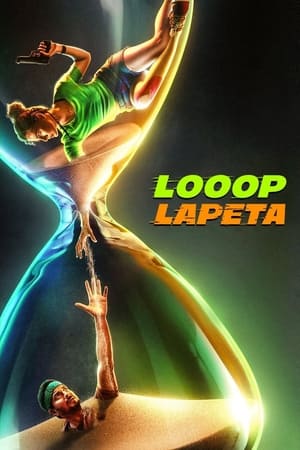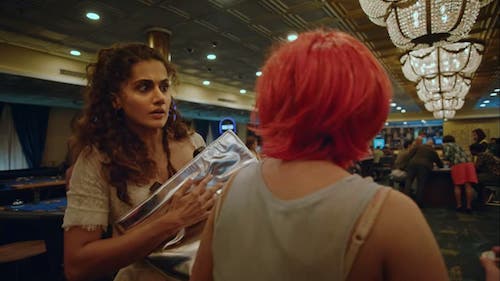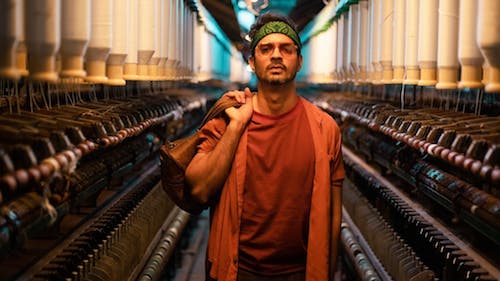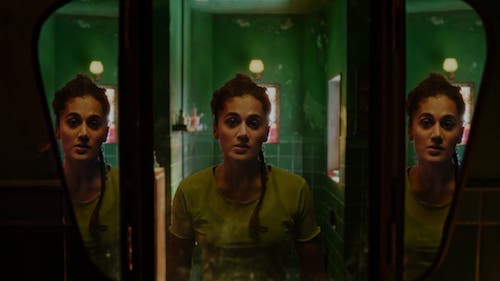
Many happy returns
Bollywood remakes a lot of films from across the globe, applying the inimitable stamp of Indian filmmaking to such classics as Oldboy (Zinda, 2006), Reservoir Dogs (Kaante, 2002), Mrs. Doubtfire (Chachi 420, 1997), and even I Know What You Did Last Summer (Dhund: The Fog, 2003). Even if it takes a couple of years for an international film to get into the hands of Bollywood producers, they still usually take on projects that are relatively recent hits. Which is why I’m perplexed about the existence of Looop Lapeta, Netflix and Aakash Bhatia’s remake of the 1998 German classic Run Lola Run (Lola rennt). The time was not exactly ripe. Hell, the lesbian remake And Then Came Lola was already a little late to the party in 2009. Nevertheless, Looop Lapeta is proudly inspired by Tom Tykwer’s magnum opus.
Because a Bollywood film wouldn’t be caught dead with a run time of 82 minutes, Looop Lapeta (which clocks in at 131 minutes) expands the source material considerably. Savi (Taapsee Pannu) is a former runner who suffered a knee injury during an important race. When she attempts to throw herself from the roof of her hospital, she is saved by burnout loser Satya (Tahir Raj Bhasin), who had gone upstairs to smoke. The two become each other’s lifelines and fall in love, but one year on her birthday he gets himself into a sticky situation: he has 50 minutes to make 5 million rupees (about $67,000) or else his mob boss employer will have him killed.
Savi must run through the city, desperately finding a way to get the money without getting Satya killed. Whenever she fails, she is given another chance and the loop begins again, with different butterfly effect outcomes occurring depending on the different ways she interacts with various characters around the city, including her father (K.C. Shankar) and his lover (Varun Pande), a lovelorn cab driver (Sameer Kevin Roy), a comically bumbling cop (Bhupesh Bandekar), and the comically bumbling sons of the local jewelry store owner (Raghav Raj Kakker and Manik Papneja).
I wouldn't say having three different characters who can be described as "comically bumbling" is a comedic instinct that works for me, common as it is in Hindi filmmaking. However, the other additions that Looop Lapeta makes are surprisingly solid. The film has very different goals than Run Lola Run, so those hoping for an action-packed thriller may find that this substantially more rom-com-oriented crime movie doesn't go down quite right. However, there is a thematic tightness to the script that boggles the mind in terms of how well it takes the thread of the source film and makes it just one part of a well-woven tapestry.

Looop Lapeta is very interested in building Savi as a character, so they also make the decision to add a Groundhog Day element to the time loop plot here. Savi specifically remembers and learns from her previous mistakes, and the repeated visual motif of running is used as a robust metaphor for connecting her past as a literal runner to her current dilemma of finding the path for her future, both in the short-term "my boyfriend will be cooked in an oven like a turkey" way and the long-term "I need to reassess my life goals" way.
Accompanying this impressively tight screenplay is a beautifully confident stylized aesthetic. Looop Lapeta is awash in color, both in minor character-building details (Savi's bright pink knee wrap is an excellent homage to Lola's iconic red hair) and in major "Suspiria who?" setpieces like the rooftop that is drenched in otherworldly neon. I could kiss this movie merely for choosing pink and green as its major colors rather than orange and teal, but every element of its visual schema is thought through and well-executed.
Looop Lapeta isn't interested in using style just to show off (although, frankly, it would be OK if it was). Every moment of heightened style, from its Edgar Wright quick-cut editing to the constant spinning camera that mimics the hands of a clock, is bolstering the mood of the scene, emphasizing the characters' frantic and unpredictable circumstances. Although its interest in stylistic fillips falls away in the third act, it's beautiful and stimulating to gaze at from frame one.

The place where the film is weakest is, as I have already hinted, its comedy. Comedy is the thing that translates the worst across cultures, so this isn't necessarily the fault of the movie, but many Western viewers will likely face the same stumbling blocks that I did. There is only one bit that really works here, something that seems direly unfunny (like the rest of this film's comic relief) at first blush but becomes a running gag that is reconstituted in so many satisfying ways that it flips around and becomes a reasonably strong joke.
At the end of the day, Looop Lapeta is doing a lot more than Run Lola Run. While it is doing most of those things well, that fact is not intrinsically a good thing. It inherently lacks the immediacy and energy that make Run Lola Run such an effervescent action classic. Before you even account for the fact that it packs far fewer high octane moments in a much more sprawling run time, no individual action moment can hold a candle to any comparable scene from Lola. It also uses none of those extra minutes to do a dance number, which is just insulting. Though, in true Bollywood fashion, the lead actors sing the main theme from the film and it's a genre-mashing, propulsive electro banger.
Even with its downsides, it's a remake that is far from perfect but fully justifies its reason to exist, which is something that we're much less good at making over here in the States.
Brennan Klein is a millennial who knows way more about 80's slasher movies than he has any right to. He's a former host of the Attack of the Queerwolf podcast and a current senior movie/TV news writer at Screen Rant. You can find his other reviews on his blog Popcorn Culture. Follow him on Twitter or Letterboxd, if you feel like it.
Because a Bollywood film wouldn’t be caught dead with a run time of 82 minutes, Looop Lapeta (which clocks in at 131 minutes) expands the source material considerably. Savi (Taapsee Pannu) is a former runner who suffered a knee injury during an important race. When she attempts to throw herself from the roof of her hospital, she is saved by burnout loser Satya (Tahir Raj Bhasin), who had gone upstairs to smoke. The two become each other’s lifelines and fall in love, but one year on her birthday he gets himself into a sticky situation: he has 50 minutes to make 5 million rupees (about $67,000) or else his mob boss employer will have him killed.
Savi must run through the city, desperately finding a way to get the money without getting Satya killed. Whenever she fails, she is given another chance and the loop begins again, with different butterfly effect outcomes occurring depending on the different ways she interacts with various characters around the city, including her father (K.C. Shankar) and his lover (Varun Pande), a lovelorn cab driver (Sameer Kevin Roy), a comically bumbling cop (Bhupesh Bandekar), and the comically bumbling sons of the local jewelry store owner (Raghav Raj Kakker and Manik Papneja).
I wouldn't say having three different characters who can be described as "comically bumbling" is a comedic instinct that works for me, common as it is in Hindi filmmaking. However, the other additions that Looop Lapeta makes are surprisingly solid. The film has very different goals than Run Lola Run, so those hoping for an action-packed thriller may find that this substantially more rom-com-oriented crime movie doesn't go down quite right. However, there is a thematic tightness to the script that boggles the mind in terms of how well it takes the thread of the source film and makes it just one part of a well-woven tapestry.

Looop Lapeta is very interested in building Savi as a character, so they also make the decision to add a Groundhog Day element to the time loop plot here. Savi specifically remembers and learns from her previous mistakes, and the repeated visual motif of running is used as a robust metaphor for connecting her past as a literal runner to her current dilemma of finding the path for her future, both in the short-term "my boyfriend will be cooked in an oven like a turkey" way and the long-term "I need to reassess my life goals" way.
Accompanying this impressively tight screenplay is a beautifully confident stylized aesthetic. Looop Lapeta is awash in color, both in minor character-building details (Savi's bright pink knee wrap is an excellent homage to Lola's iconic red hair) and in major "Suspiria who?" setpieces like the rooftop that is drenched in otherworldly neon. I could kiss this movie merely for choosing pink and green as its major colors rather than orange and teal, but every element of its visual schema is thought through and well-executed.
Looop Lapeta isn't interested in using style just to show off (although, frankly, it would be OK if it was). Every moment of heightened style, from its Edgar Wright quick-cut editing to the constant spinning camera that mimics the hands of a clock, is bolstering the mood of the scene, emphasizing the characters' frantic and unpredictable circumstances. Although its interest in stylistic fillips falls away in the third act, it's beautiful and stimulating to gaze at from frame one.

The place where the film is weakest is, as I have already hinted, its comedy. Comedy is the thing that translates the worst across cultures, so this isn't necessarily the fault of the movie, but many Western viewers will likely face the same stumbling blocks that I did. There is only one bit that really works here, something that seems direly unfunny (like the rest of this film's comic relief) at first blush but becomes a running gag that is reconstituted in so many satisfying ways that it flips around and becomes a reasonably strong joke.
At the end of the day, Looop Lapeta is doing a lot more than Run Lola Run. While it is doing most of those things well, that fact is not intrinsically a good thing. It inherently lacks the immediacy and energy that make Run Lola Run such an effervescent action classic. Before you even account for the fact that it packs far fewer high octane moments in a much more sprawling run time, no individual action moment can hold a candle to any comparable scene from Lola. It also uses none of those extra minutes to do a dance number, which is just insulting. Though, in true Bollywood fashion, the lead actors sing the main theme from the film and it's a genre-mashing, propulsive electro banger.
Even with its downsides, it's a remake that is far from perfect but fully justifies its reason to exist, which is something that we're much less good at making over here in the States.
Brennan Klein is a millennial who knows way more about 80's slasher movies than he has any right to. He's a former host of the Attack of the Queerwolf podcast and a current senior movie/TV news writer at Screen Rant. You can find his other reviews on his blog Popcorn Culture. Follow him on Twitter or Letterboxd, if you feel like it.
Categories: indian cinema, netflix originals






